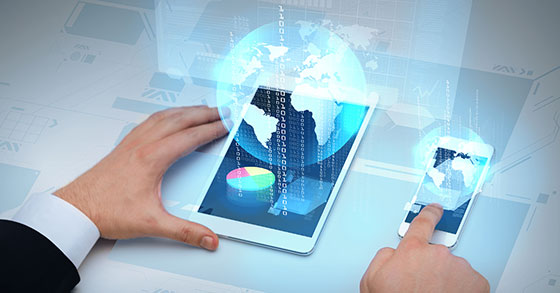It's a New World!: Technological Convergence Brings Sweeping Changes

Throughout modern history, periods of heightened innovation and technological advance were followed by a relatively radical step up in the human condition as new industries, processes, routines, and services became commonplace. In the mid- to late-1800s, the United States became truly united with the completion of the transcontinental railroad and interconnected waterways, while subsequent advances in electricity, plumbing, engineering, and medicine accelerated the efficiencies of life and business dramatically.
Recent advances in such things as robotics, computer processing and storage, sensors, materials science, and synthetic biotechnology have brought us to the verge of another new era, one with significant long-term implications for investors. While many of these technologies have been around for decades, recent progress has brought us to a critical point of convergence, teeing up the global markets for intense change. In much the same way that multiple tributaries come together to form a mighty rushing river, we expect this convergence to vastly change and drive the world to a new and higher plane.
The bulk of these developments are beneficial to emerging economies, which can use new technological advances to leapfrog developed countries that have aging installed infrastructure. If deployed correctly, these technologies could benefit people across the world, transforming nations and moving billions of people into the global middle class.
While computers have been around for decades, their applicability and ubiquity have been driven by steep declines in price and size, and increased processing power. Today's $400 iPhone, for example, contains the same processing power that a $5 million supercomputer did in 1975.
Similarly, inexpensive access to data has altered all sorts of daily interactions, jobs, and job descriptions. Thirty years ago, we used encyclopedias and libraries to find information. Today, Google responds to 6 billion inquiries a day, and Wikipedia is a constantly improving, a richer trove of free information than even the most complete encyclopedia set was a decade or two ago. The era of Big Data is here and we have only begun to exploit its implications. We don't just have chemists and biologists, we now have a need for data scientists. We've moved from servers to the cloud, where good credit and a great idea can launch a business in a matter of days.
One of the most important attributes of all of these changes is that they are distributed broadly and facilitate many applications for social interactions. While many decry the fact that in-person interactions are being changed by technology, the flip side is the increasing ability to connect with an ever-broader pool of family, friends, co-workers, and others. Government agencies such as NASA regularly "distribute" challenges and problems on the web for scientists and casual problem-solvers alike to noodle on. Social media, the Internet, and services like FaceTime, Instagram, Pinterest, and Facebook allow for the nearly instantaneous--and sometimes viral--transmission of ideas. Take the recent "ALS Ice Bucket Challenge" for example, which took Facebook by storm, ensnared the current and several former U.S. presidents, and quickly raised tens of millions of dollars. Industry after industry has been irrevocably changed by converging technologies. Here are just a few examples:
- Google's driverless cars have logged 500,000 miles on traffic-congested California highways with just a single accident. That accident, incidentally, was caused by a human overriding the car's system.
- Sensors (basically, incredibly small, light, cheap, and virtually disposable computers) are on just about everything, and the Internet of Things has arrived. Amazon, Walmart, FedEx, etc. track and move goods through their distribution facilities and delivery networks by barcoding and installing sensors on everything. By some estimates, 9 billion "things" are already connected to the Internet with the expectation that 1 trillion will be within the next 20 years.
- Sensors on bridges already tell us when repairs are needed. Sensors in airplane parts can radio repair teams on the ground to have new parts ready when a plane lands.
- Sensors on pill bottles can be used to track restricted substances through all phases of distribution and use. Sensors worn by the elderly can alert caregivers when a fall occurs, a meal is eaten, and help prolong independent living.
- Vastly improved imaging techniques and nanomaterials have put the U.S. on the verge of being the world's largest exporter of oil and gas. This vision of the future is the exact opposite of the post-peak-oil environment pundits had placed us in less than a decade ago.
What's ahead for investors
These advances are exciting for consumers, business owners, and investors alike. Unfortunately, given the pace of change, it is tough to predict with any specificity precisely how they will all play out--particularly when it comes to investment implications.
Many benefits are likely to accrue to large, well-heeled and cash-rich old line companies that can adapt and adopt quickly. Similarly, investing in cash-rich technology companies with active research arms and numerous investments in new technologies is probably a safer way to play transformative technologies than trying to "bet" on a single IPO. Change and creative destruction are part and parcel of a free market society. While those can be frustrating for individuals caught in the gears of that change, they are a necessary force in moving the entire system ahead.
At the turn of the 1900s, if the U.S. had focused on subsidizing dying buggy whip and wagon wheel industries at the expense of spending on electrification, enhanced manufacturing, and plumbing, think how vastly different subsequent decades may have played out. Similarly today, the core need for investors, employees, and citizens in general is to stay watchful and nimble as implications of convergence present themselves in the years ahead.
My full perspective on "Convergence: Transforming technologies in the early 21st century" can be found on the insights page of the abbotdowning.com website.
Carol M. Schleif, CFA, is regional chief investment officer for Abbot Downing, a Wells Fargo business that provides products and services through Wells Fargo Bank, N.A. and its affiliates and subsidiaries. She welcomes questions and comments at carol.schleif@abbotdowning.com.
Share this Feature
Recommended Reading:
Comments:
comments powered by DisqusFRANCHISE TOPICS
- Multi-Unit Franchising
- Get Started in Franchising
- Growth
- Operations
- Open New Units
- Leadership
- Marketing
- Technology
- Legal
- Awards
- Rankings
- Trends
- Featured Franchise Stories
FEATURED IN

Multi-Unit Franchisee Magazine: Issue 4, 2014
$250,000
$150,000




 The multi-unit franchise opportunities listed above are not related to or endorsed by Multi-Unit Franchisee or Franchise Update Media Group. We are not engaged in, supporting, or endorsing any specific franchise, business opportunity, company or individual. No statement in this site is to be construed as a recommendation. We encourage prospective franchise buyers to perform extensive due diligence when considering a franchise opportunity.
The multi-unit franchise opportunities listed above are not related to or endorsed by Multi-Unit Franchisee or Franchise Update Media Group. We are not engaged in, supporting, or endorsing any specific franchise, business opportunity, company or individual. No statement in this site is to be construed as a recommendation. We encourage prospective franchise buyers to perform extensive due diligence when considering a franchise opportunity.